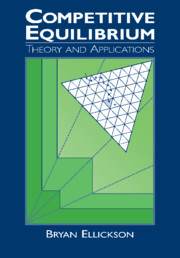3 - Aumann's model
Published online by Cambridge University Press: 04 December 2009
Summary
In most models with a finite number of consumers the core is larger than the set of Walrasian equilibria. What is this telling us? Perhaps that the core is a flabby concept, Walrasian equilibrium precise. But, more likely, this discrepancy signals a problem with the Walrasian hypothesis of price-taking behavior. In most situations where the Walrasian model has been applied, consumers can influence price. The core recognizes the associated opportunities to haggle and bargain. Walrasian equilibrium assumes them away.
Of course, economists have an answer to this criticism. We are not that naive! Although we illustrate the competitive model with an Edgeworth box, the typical applications we have in mind involve not two consumers but many, so many that each consumer has a negligible influence on price. In 1964 the game theorist Robert Aumann made a bold suggestion: if economists intend their models of competition to apply in situations where consumers have negligible influence on price, why not reformulate the model to be consistent with this tacit assumption? The opening two paragraphs of his paper state the case with great force and clarity:
The notion of perfect competition is fundamental in the treatment of economic equilibrium. The essential idea of this notion is that the economy under consideration has a “very large” number of participants, and that the influence of each participant is “negligible.” Of course, in real life no competition is perfect; but, in economics, as in the physical sciences, the study of the ideal state has proved very fruitful, though in practice it is, at best, only approximately achieved. […]
- Type
- Chapter
- Information
- Competitive EquilibriumTheory and Applications, pp. 99 - 150Publisher: Cambridge University PressPrint publication year: 1994



